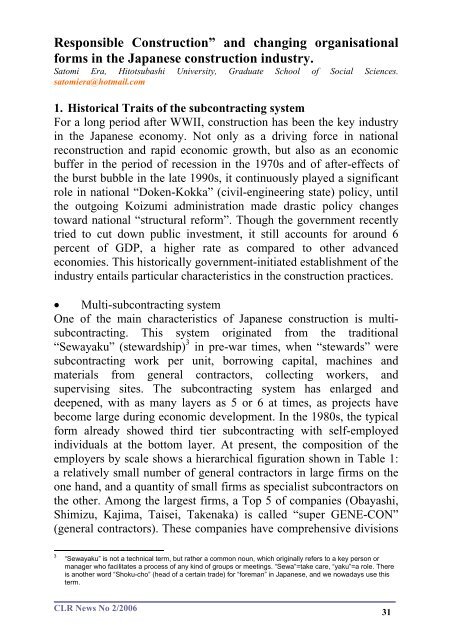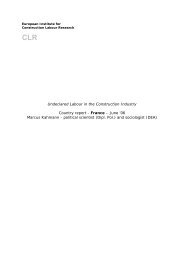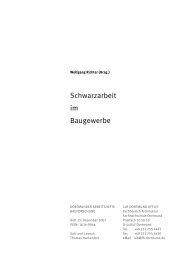Responsible <strong>Construction</strong>” and changing organisationalforms in the <strong>Japan</strong>ese construction industry.Satomi Era, Hitotsubashi University, Graduate School of Social Sciences.satomiera@hotmail.com1. Historical Traits of the subcontracting systemFor a long period after WWII, construction has been the key industryin the <strong>Japan</strong>ese economy. Not only as a driving force in nationalreconstruction and rapid economic growth, but also as an economicbuffer in the period of recession in the 1970s and of after-effects ofthe burst bubble in the late 1990s, it continuously played a signifi<strong>can</strong>trole in national “Doken-Kokka” (civil-engineering state) policy, untilthe outgoing Koizumi administration made drastic policy changestoward national “structural reform”. Though the government recentlytried to cut down public investment, it still accounts for around 6percent of GDP, a higher rate as compared to other advancedeconomies. This historically government-initiated establishment of theindustry entails particular characteristics in the construction practices.• Multi-subcontracting systemOne of the main characteristics of <strong>Japan</strong>ese construction is multisubcontracting.This system originated from the traditional“Sewayaku” (stewardship) 3 in pre-war times, when “stewards” <strong>we</strong>resubcontracting work per unit, borrowing capital, machines andmaterials from general contractors, collecting workers, andsupervising sites. The subcontracting system has enlarged anddeepened, with as many layers as 5 or 6 at times, as projects havebecome large during economic development. In the 1980s, the typicalform already sho<strong>we</strong>d third tier subcontracting with self-employedindividuals at the bottom layer. At present, the composition of theemployers by scale shows a hierarchical figuration shown in Table 1:a relatively small number of general contractors in large firms on theone hand, and a quantity of small firms as specialist subcontractors onthe other. Among the largest firms, a Top 5 of companies (Obayashi,Shimizu, Kajima, Taisei, Takenaka) is called “super GENE-CON”(general contractors). These companies have comprehensive divisions3“Sewayaku” is not a technical term, but rather a common noun, which originally refers to a key person ormanager who facilitates a process of any kind of groups or meetings. “Sewa”=take care, “yaku”=a role. Thereis another word “Shoku-cho” (head of a certain trade) for “foreman” in <strong>Japan</strong>ese, and <strong>we</strong> nowadays use thisterm.CLR News No 2/200631
of architectural design, engineering, research and development as <strong>we</strong>llas a main construction division. On the other hand, more than half ofthe firms hold less than 10 million yen as capital, and 23.7% is run byone person. Table 1 shows that the largest firms (only 0.3% of thetotal number) receive 45.4% of the order with an average order byfirm that is hundred times the total average.Table 1: Number of construction firms and amount of order by firm scale, 2004capital scale (yen*) offirmnumber offirmsrateamount oforderrateaverageamount oforder perfirmOver 10 billion 1,632 0.3 24,731,691 45.4 15,154.21-10 billion 4,796 0.9 6,472,612 11.9 1,349.650 million <strong>–</strong> 1 billion 10,697 1.9 5,808,912 10.7 543.010-50 million 216,248 38.7 16,149,699 29.6 74.7Under 10 million 192,809 34.5 1,250,602 2.3 6.5Person 132,675 23.7 60,960 0.1 0.5Total 558,857 100.0 54,474,275 100.0 97.5Data source: Ministry of Land, Infrastructure and Transport, Policy Bureau* 1 yen = 114 US dollar, 144 €• Employment practice in a peripheral labour marketIn labour research studies, researchers often note that constructionprojects inevitably entail subcontracting systems because of thevulnerability to seasonable and market demand or the specific needsfor individual skills and workforce in a particular project. In <strong>Japan</strong>, inaddition to these industrial traits in the production system, theconstruction labour market as a whole is destined to be a secondarylabour market for absorbing redundant workforces from otherindustries, which means most workers have historically been recruitednot from new graduates or younger apprentices, but from domesticmigrants from rural areas or from the unemployed. On the one hand,public investment guarantees relatively stable market demand; one theother, there have been few regulations established for protectingworking conditions or rights in subcontracting employment practices.This is quite a contrast to <strong>Japan</strong>ese conventional employment practiceof internal and lifelong employment in the primary labour market.Therefore, construction work is more or less stigmatised as a lo<strong>we</strong>rstatus job. This also reflects recent problems: the crisis of aging ofCLR News No 2/200632
- Page 1 and 2: No 2/2006Japan - what can we learn?
- Page 3 and 4: separate nation states, local build
- Page 6: "shortening of exploitation's horiz
- Page 10 and 11: The Japanese construction industry
- Page 12 and 13: time could be up to 50 or more hour
- Page 14 and 15: The differences between sites in th
- Page 16 and 17: most of its importance since then.
- Page 18: But asked, who decides on the wages
- Page 21 and 22: policy were Toyota, Nissan, Canon,
- Page 23 and 24: Figure 2 C om position of Investm e
- Page 25 and 26: 3.2 Investment sheetSecondary, the
- Page 27 and 28: Maintenance and repairN ew construc
- Page 29 and 30: period of continuous cut back of or
- Page 31: enterprises, such as Nippon Steel C
- Page 35 and 36: is constructed without blueprints.
- Page 37 and 38: task over again bearing the cost of
- Page 39 and 40: outsource every production function
- Page 41 and 42: so that any significant changeover
- Page 43 and 44: sixties or seventies who have retir
- Page 45 and 46: Immigration law allows residential
- Page 47 and 48: Today, domestic construction demand
- Page 49 and 50: 1993. Then there was a decrease to
- Page 51 and 52: Hundredmillion 億 円yen1400012000
- Page 53 and 54: workers belong to enterprise-based
- Page 55 and 56: trans-enterprise or industrial nego
- Page 57 and 58: Union (DENKI RENGO), Confederation
- Page 59 and 60: unions on their part have advocated
- Page 61 and 62: again. Industry specific federation
- Page 63 and 64: consult, while involved with variou
- Page 65 and 66: that unions can bring many positive
- Page 67 and 68: Figure 1. The Image of the J-CorpCo
- Page 69 and 70: References:OKAMOTO, Hideaki(1964) "
- Page 71 and 72: Nr. 3. Stress in the European const
- Page 73 and 74: We proudly present: a new publisher









